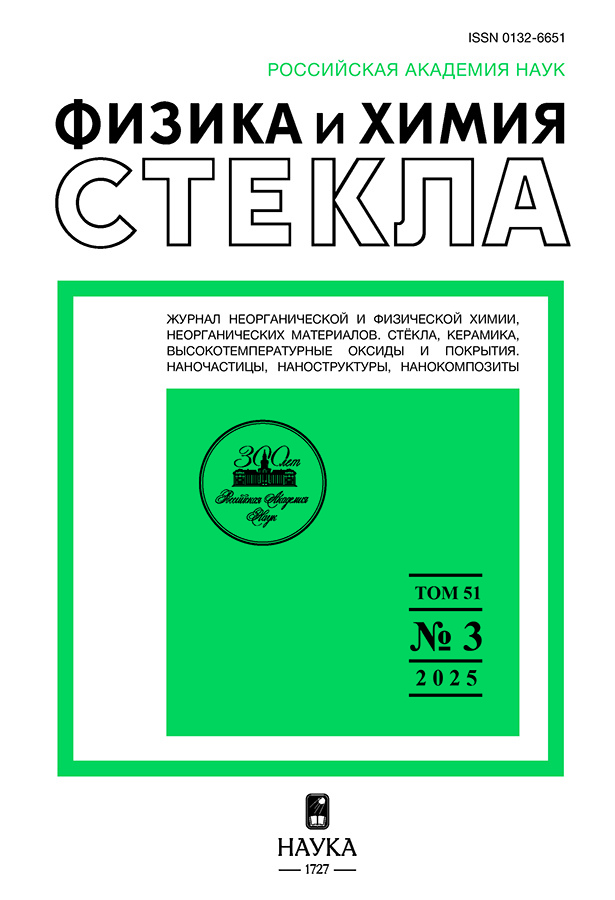Вязкость, свободная энергия активации и температура стеклования калиевоборатных расплавов K2O–B2O3
- Авторы: Хохряков А.А.1, Самойлова М.А.1, Рябов В.В.1, Ведмидь Л.Б.1, Мельчаков С.Ю.1
-
Учреждения:
- Институт металлургии Уральского отделения РАН
- Выпуск: Том 49, № 3 (2023)
- Страницы: 267-275
- Раздел: Статьи
- URL: https://medjrf.com/0132-6651/article/view/663257
- DOI: https://doi.org/10.31857/S0132665122600789
- EDN: https://elibrary.ru/SJMDAE
- ID: 663257
Цитировать
Полный текст
Аннотация
Вязкость калиевоборатных расплавов измерена в интервале температур 918–1699 K с помощью вибрационного вискозиметра. Содержание оксида калия в расплавах варьировалось от 0.74 до 28.46 мол. %. С использованием конфигурационно-активационной модели рассчитаны параметры энергии активации вязкого течения стеклующихся расплавов (конфигурационная энергия активации (εh) и энергия переключения мостиковых кислородных связей (U∞)) для двух температурных интервалов 918–1400 K и 1400–1699 K. Методом дифференциальной сканирующей калориметрии определена температура стеклования (Tg) расплавов, построена концентрационная зависимость температуры стеклования от содержания оксида калия в расплаве.
Об авторах
А. А. Хохряков
Институт металлургии Уральского отделения РАН
Email: mari.makarenko.1993@mail.ru
Россия, 620016, Екатеринбург, ул. Амундсена, 101
М. А. Самойлова
Институт металлургии Уральского отделения РАН
Email: mari.makarenko.1993@mail.ru
Россия, 620016, Екатеринбург, ул. Амундсена, 101
В. В. Рябов
Институт металлургии Уральского отделения РАН
Email: mari.makarenko.1993@mail.ru
Россия, 620016, Екатеринбург, ул. Амундсена, 101
Л. Б. Ведмидь
Институт металлургии Уральского отделения РАН
Email: mari.makarenko.1993@mail.ru
Россия, 620016, Екатеринбург, ул. Амундсена, 101
С. Ю. Мельчаков
Институт металлургии Уральского отделения РАН
Автор, ответственный за переписку.
Email: mari.makarenko.1993@mail.ru
Россия, 620016, Екатеринбург, ул. Амундсена, 101
Список литературы
- Nakashima K., Kawagoe T., Ookado T., Mori K. Viscosity of Binary Borate and Ternary Borosilicate Melts. // Slags, Fluxes and Salts. Conference.1997. P. 215.
- Воларович М.П., Фридман P.C. Исследование вязкости системы K2В4O7–В2O3 в расплавленном состоянии // Журн. Физической Химии. 1937. Т. 9. № 2. С. 177–181.
- Brosh I.E., Pelton A.D., Decterov S.A. A model to calculate the viscosity of silicate melts Part IV: Alkali-free borosilicate melts // International J. Materials Research (formerly Zeitschrift fuer Metallkunde). 2012. V. 103. № 5. P. 494.
- Coughanour L.W., Shartsis L., Shermer H.F. Viscosity, Density, and Electrical Resistivity of Molten Alkaline-Earth Borate Glasses with 3 Mol. % of Potassium Oxide // J. American Ceramic Society. 1958. V. 41. № 8. P. 324–329.
- Shartsis L., Capps W., Spinner S. Density, Expansivity, and Viscosity of Molten Alkali Silicates // J. American Ceramic Society. 1953. V. 36. № 10. P. 319–326.
- Мельчаков С.Ю., Хохряков А.А., Самойлова М.А., Рябов В.В., Ягодин Д.А. Вязкость и свободная энергия активации вязкого течения натриевоборатных расплавов // Физ. и хим. стекла. 2022. Т. 48. № 3. С. 253–261.
- Мельчаков С.Ю., Хохряков А. А., Самойлова М. А., Рябов В.В. Исследование зависимостей вязкости и энергии активации вязкого течения литиевоборатных расплавов от содержания оксида лития // Неорганические материалы. 2022. Т. 58. № 5. С. 1–7.
- Соловьев А.Н., Каплун А.Б. Вибрационный метод измерения вязкости жидкостей. Новосибирск: Наука, 1970. 140 с.
- Штенгельмейер С.В., Прусов В.А., Бочегов В.А. Усовершенствование методики измерения вязкости вибрационным вискозиметром // Заводская лаборатория. 1985. Т. 51. № 9. С. 56–57.
- Козин Р.В., Григоренко Г.М. Физико-химические свойства флюсов для электрошлаковых технологий // Современная металлургия. 2016. Т. 125. № 4. С. 10–15.
- Осипов А.А., Осипова Л.М., Быков В.Н. Спектроскопия и структура щелочноборатных стекол. Екатеринбург–Миасс: УрО РАН. 2009. 174 с.
- Голубков В.В. Структура В2О3 и щелочных боратов в стеклообразном и расплавленном состояниях // Физ. и хим. стекла. 1992. Т. 18. № 2. С. 14–33.
- Хохряков А.А., Вершинин А.О., Пайвин А.С., Истомин С.А. Электронные спектры расплавленных смесей хNa2O–(100 – x)B2O3 и хNa2O–(100 – x)B2O3–Re2O3 (Re = Sm, Eu) // Расплавы. 2017. № 6. С. 538–549.
- Handa K., Kita Y. Structure of M2O–B2O3 (M: Na and K) glasses and melts by neutron diffraction // J. Physics and Chemistry of Solids 1999. V. 60. P. 1465–1471.
- Umesaki N., Kira Y. Structure of K2O–B2O3 Glasses and Melts // Electrochemistry. 1999. № 6. P. 541–546.
- Akagi R., Umesaki N. Raman spectra of K2O–B2O3 glasses and melts. // J. Non-Crystalline Solids. 2001. V. 293. № 1. P. 471–476.
- Сандитов Д.С. Сдвиговая вязкость стеклообразующих расплавов в области перехода “жидкость–стекло” // Доклады АН 2005. Т. 403. С. 498–501.
- Boora M. Malik S., Kumar V., Bala M., Arora S., Rohilla S., Kumar A., Dalal J. Investigation of structural and impedance spectroscopic properties of borate glasses with high Li+ concentration. // Solid State Ionics. 2021. V. 368. P. 115704.
- Chryssikos G.D., Kamitsos E.I. Effect of Li2SO4 on the structure of Li2O–B2O3 glasses // J. Non-Crystalline Solids. 1996. V. 202. № 3. P. 222–232.
- Green R.L. X-ray diffraction and physical properties of potassium borate glasses // J. American Ceramic Society. 1942. V. 25. № 3. P. 83.
- Poch W. Vollständige Entwässerung einer B2O3 – Schmeize und einige Eigenschaftswerte des daraus erhaltenen Glases. // Glastech. Ber. 964. V. 37. P. 533–535.
Дополнительные файлы

















